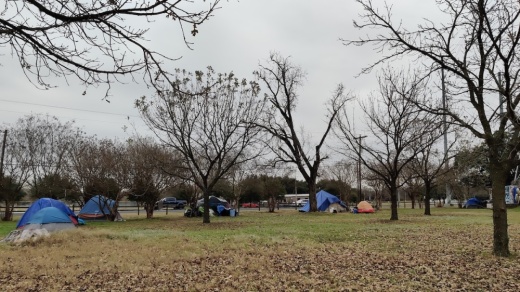Nearly 150 people living in encampments were moved into shelter last year through the first phase of Austin’s Housing-Focused Encampment Assistance Link, or HEAL, program. The initiative was launched to clear camps of high concern and connect those experiencing homelessness with shelter and support services.
Council voted last summer to spend around $6 million on a second round of the program in fiscal year 2021-22. So far through HEAL Phase 2, the city says around 40 people at two public encampments have been moved into shelter. The most recent HEAL clearing took place mid-January at St. Johns Avenue and I-35.
After Proposition B passed last spring, the city moved to more strictly enforce its homeless ordinances by late summer. Despite that policy allowing police to cite and potentially arrest anyone violating the bans, tents and encampments continue to appear around town including in highway underpasses and parkland such as the Ann and Roy Butler Hike and Bike Trail. City data shows just over 200 citations for camping and sitting, sleeping or lying down have been issued as of early February.
The city said its current clearing efforts are based on a variety of factors including a camp’s presence in public spaces.
“The prioritization of encampments for the HEAL Initiative is a dynamic process, such that there is not a static list of targeted sites,” a city spokesperson said in January. “HEAL operates citywide, but the assessment of potential sites does take into consideration whether an encampment is creating barriers to the general public’s access to community resources such as park facilities.”
During a Feb. 1 briefing to City Council, Homeless Strategy Officer Dianna Grey said the limited HEAL process is on track to meet a goal of sheltering 200 people by the end of September. However, she added that residents' requests for city assistance at dozens of encampments have "far outstripped" Austin's ability to respond to each site that pops up.
“Unfortunately at present, we’ve not been able to assemble the resources quite yet to be able to offer that permanent housing to everyone who is the subject of enforcement of the camping ordinance," Grey said. "We are very intentional about focusing on essentially protecting life. And so looking at those encampments where the concerns around public health and public safety are the greatest.”
Grey said just three city departments have had to clear more than 1,000 tons of garbage from "just a few" camps in recent months, while the Austin Fire Department has responded to more than 320 fires at encampments since August. And even if a camp is successfully cleared, without an immediate housing connection, Grey said residents often move "just down the road."
“We know that there is frustration in the community, but there’s also very significant strain on budgets, on staff, and on services as departments’ attention is drawn from their other activities as well," she said.
The housing and shelter work comes as the local homeless population has continued to grow, according to data from nonprofit Ending Community Homelessness Coalition, or ECHO. From February to November 2021, ECHO tracked a more than an 18% increase in the estimated number of people experiencing homelessness in the Austin area. Setting up housing
The city currently operates two bridge shelters in former hotels along I-35 that have served participants in the HEAL program, and new supportive apartment complexes for those exiting homelessness are planned. Those properties, located at 13311 Burnet Road and 10811 Pecan Park Blvd., Bldg. 2, will be the next to open following six- to eight-month rehabilitation.
Council on Feb. 3 approved a $1.36 million contract with Integral Care for the renovation and management of the Burnet facility. Now known as Bungalows at Century Park, 60 studio units at the complex will open in late 2022.
“This new apartment building will advance our community’s efforts to address homelessness for many years to come,” Grey said in a statement. “It’s part of a broader citywide effort to ensure that hundreds of our most vulnerable neighbors are given the support they need to live healthy, stable, independent lives in the community.”
Council also authorized the creation of a new city nonprofit to oversee the Pecan Park site Feb. 3. Funding for renovations and operations at that 78-unit complex is likely to be approved by council this spring, and apartments are expected to open there late this year.
While Austin's annual budget includes tens of millions of dollars to address homelessness, the city's work is proceeding alongside a regional plan to end homelessness that began last year and is now called Finding Home ATX. The hotel conversions represent part of a pipeline the city said will establish 1,000 new housing spaces over the next three years, contributing to the Finding Home goal of housing 3,000 people through 2024.
A Finding Home representative did not respond to a question about the plan's housing progress so far as of publication time. The most recent benchmark for the plan called for 400 people to be housed as of December.
Grey told council in February that more than 80% of the $515 million needed for Finding Home has been secured or committed so far, with an additional $14 million added since October. Funding comes from the city and Travis County as well as local nonprofits, businesses and philanthropists, and a gap of just over $100 million now remains.





